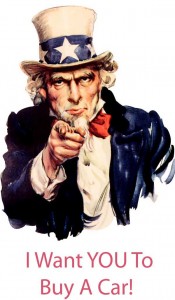 Auto sales are one way we take the economy’s temperature. Hot sales mean hot activity overall while an economic chill sends the sales-volume mercury plunging. But is putting a flame to the thermometer — subsidizing car sales in particular — a good way to re-heat the economy as a whole? Many policymakers hope so.
Auto sales are one way we take the economy’s temperature. Hot sales mean hot activity overall while an economic chill sends the sales-volume mercury plunging. But is putting a flame to the thermometer — subsidizing car sales in particular — a good way to re-heat the economy as a whole? Many policymakers hope so.
This week the U.S. Senate passed a measure, co-sponsored by Senators Barbara Mikulski (D-MD) and Sam Brownback (R-KS), to make interest payments on new car loans and state new car sales taxes deductible through the end of 2009. Offering her proposal, Sen. Mikulski said, “no matter how much government aid we give to the Big 3 auto makers, they can’t survive if consumers don’t start buying cars. That’s where my amendment helps.”
The sales crash was dramatic and it doesn’t look like things will pick up soon on their own. 2008 was the worst year since 1992, with a 13 million unit tally well down from the 16 million or more cars and light trucks that had been moving annually. Analysts project even worse sales in 2009.
The collapse is hitting all automakers as well as the nationwide matrix of suppliers and other firms whose fortunes are tied directly or indirectly to the car market. And with the run-up in fuel prices that peaked just as the financial crisis hit, the impact shattered the truck-dependent Detroit 3 worst of all.
According to the office of Rep. Don Manzullo (R-IL), who offered a “Get America Moving Again” vehicle purchase tax credit (yet-to-be-adopted in the House of Representatives), the past year’s drop in auto sales removed $175 billion from the U.S. economy.
But isn’t that a symptom rather than the disease? By comparison, higher oil prices over the past five years drained an average of $280 billion per year from the pockets of American consumers. That’s a total of $1.4 trillion since 2003, an economic de-stimulus of massive proportion.
It didn’t take much to topple the house of cards that had been erected in financial markets. Moreover, though no one in this industry was complaining, it’s not clear that the high sales levels were all that healthy. Twenty-twenty hindsight views it as just one more manifestation of America’s over-reaching on debt. Credit was easy and leasing was long, and much like the adjustable-rates and balloon mortgages — to say nothing of the over-leveraged investment schemes — it all came crashing down.
While proposals to heat up car sales might do so a bit, the prevailing wisdom is that they really won’t do much to help economic fundamentals, which are far more important for healthy business. Subsidizing car loans adds more consumer debt, and whatever short-run stimulus it might provide, it could prolong America’s economic disease rather than cure it.
Better to restore confidence and jobs overall through measures such as public investment and direct assistance to households. Consumers themselves can then decide which purchases they need the most without being enticed into additional debt. That’ll be the best way to help the economy recover and once it does, new car sales will rise again. They may not reach levels of the go-go years of easy credit and extended leasing. But they will reach a sustainable level to which automakers — including right-sized firms with right-priced products — must inevitably adjust.

If you would answer my e-mail and check my figures you will find that I have the answer to reviving the entire big three automobile market. However you prefer to stay in your ivory tower and ignored the only possible way for the big three automobile manufacturers and their dealers to lead the way out of America’s current depression I dare you to call me 847-466-2221